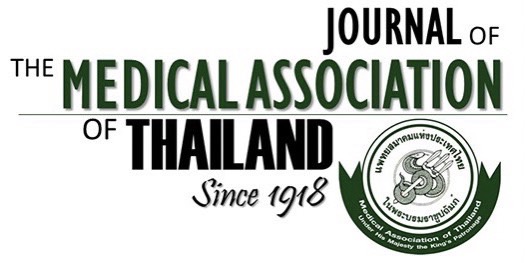Treatment Outcome of Graves’ Disease in Thai Children
Pavintara Harinsoot Somnuke MD*, Pawana Pusuwan MD**, Supawadee Likitmaskul MD*, Jeerunda Santiprabhob MD*, Pairunyar Sawathiparnich MD*
Affiliation : * Division of Pediatric Endocrinology, Department of Pediatrics, **Department of Nuclear Medicine, Faculty of Medicine Siriraj Hospital, Mahidol University, Bangkok, Thailand
Background : Graves’ disease is the most common cause of thyrotoxicosis in children. Treatment of Graves’
disease consists of anti-thyroid drugs, radioactive iodide and thyroidectomy but the optimal treatment of GD
in children is still controversial.
Objective : To review treatment outcome of Graves’ disease in Thai children.
Materials and Methods : Retrospective review of 32 children with Graves’ disease, diagnosed between Jan.1994
and Dec. 2004, at the Division of Pediatric Endocrinology, Department of Pediatrics, Faculty of Medicine
Siriraj Hospital, Mahidol University, Thailand was performed.
Results : All patients (median age 10.5 yrs, range 2.85-15 yrs) presented with goiter and increased serum T4
(median 18.4 mcg/dL, range 8.8-30 mcg/dL), serum T3 (median 443 ng/dL, range 206-800 ng/dL) and suppressed
TSH levels (median 0.009 mU/L, range 0-0.18 mU/L). Anti-thyroglobulin and Anti-microsomal antibodies
were positive in 70% and 82% respectively. All patients except two were initially treated with propylthiou-
racil (PTU). Two patients were initially treated with methimazole. Adverse reaction of PTU occurred in two
patients (One girl had arthralgia, positive pANCA, nephritis and another girl had skin rash and
arthralgia).Clinical course of 32 patients after treatment with anti-thyroid drugs mainly PTU for 3.4 (range
0.3-11.2) years is as follows: six (18.8%) underwent remission (cessation of PTU > 2 yrs), three (9.4%)
relapsed, one (3.1%) underwent subtotal thyroidectomy, and seven (21.9%) had I131 treatment. All patients (6
of 7) who received I131 dose of 100 µCi/g of thyroid tissue required more than a single dose of I131 treatment.
Further outcome in fifteen patients (46.9%) is yet to be followed. Among these patients PTU was just discon-
tinued in four and eleven had never been off anti-thyroid drugs (four still had biochemical hyperthyroidism
and seven were biochemically euthyroid).
Conclusion : PTU was the most common first line therapy in the presented patients with Graves’ disease.
Remission rate was only 18.8% after an average 3.5 years of treatment with anti-thyroid drugs. I131 or thy-
roidectomy was used as second line therapy in the present study. They were offered to those who developed
side effects, had poor compliance or failed medication. For those who received I 131, higher dose (200 µCi/g of
thyroid tissue) seemed to be more effective than the lower dose (100 µCi/g).
Keywords : Graves’ disease, Children, Antithyroid drugs, Radioactive iodide, Thyroidectomy



